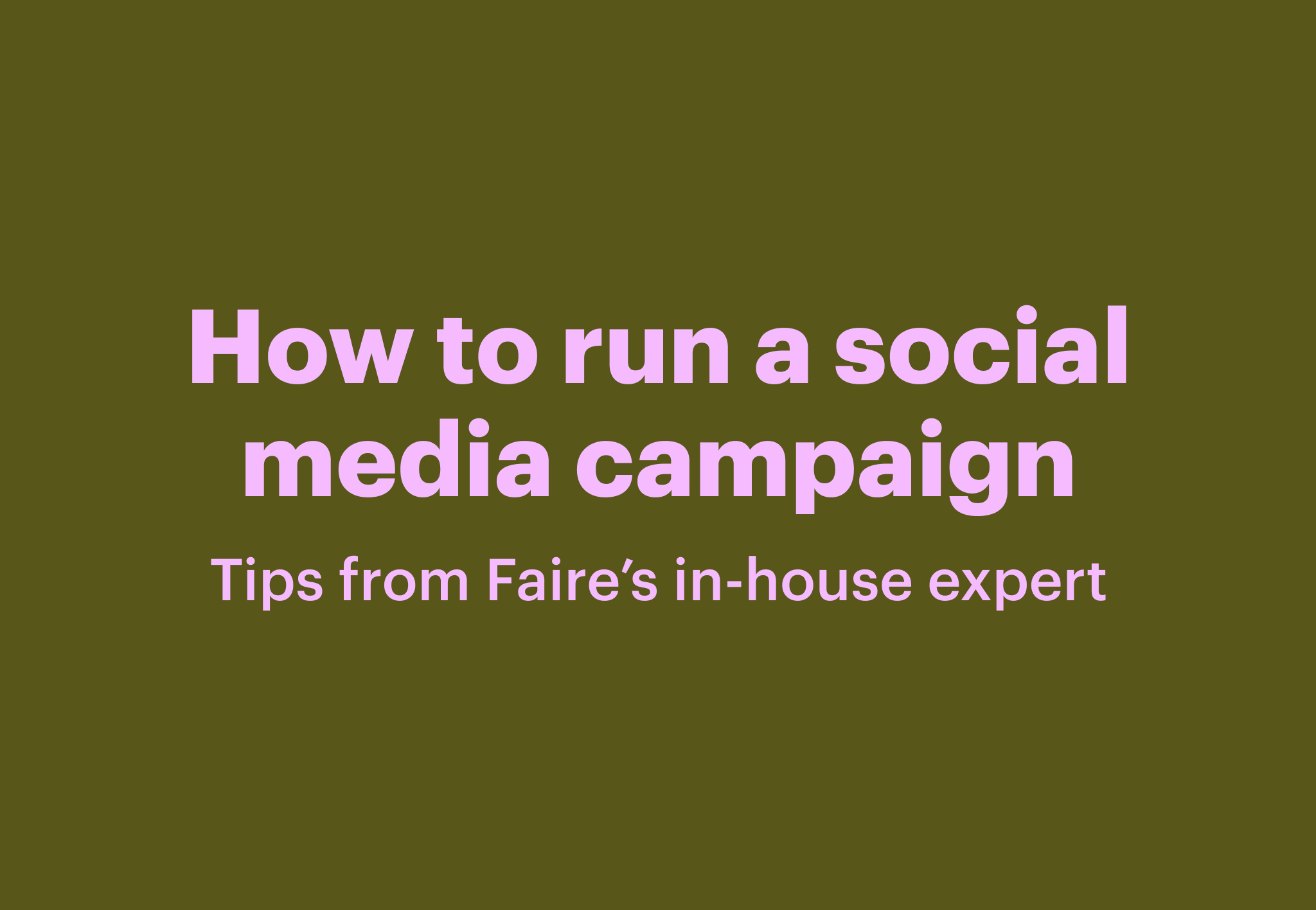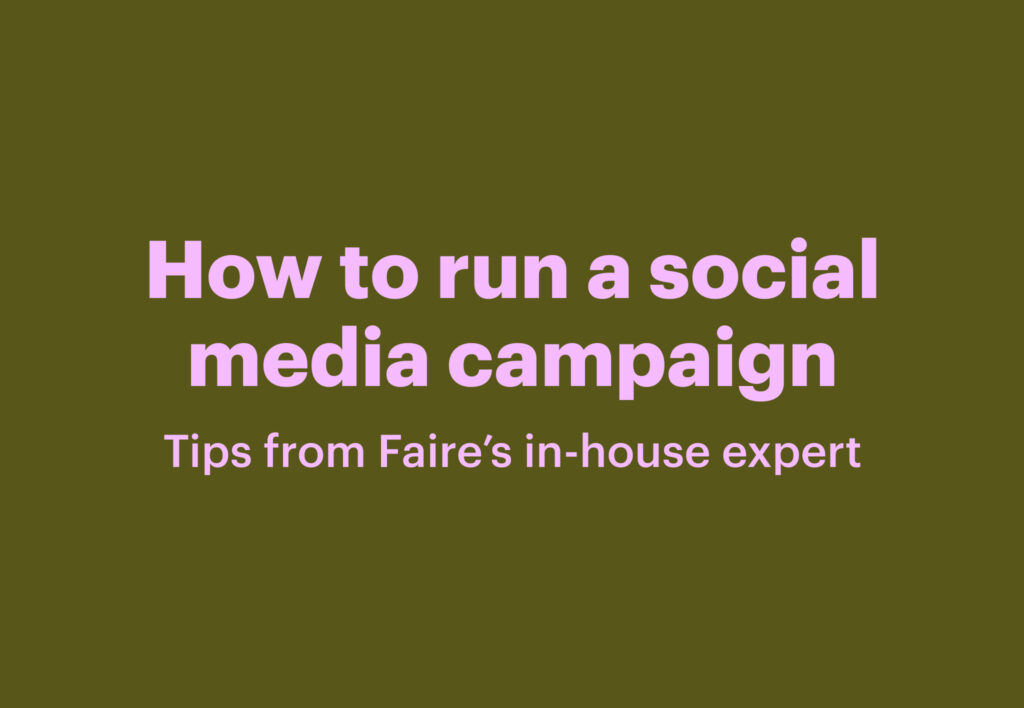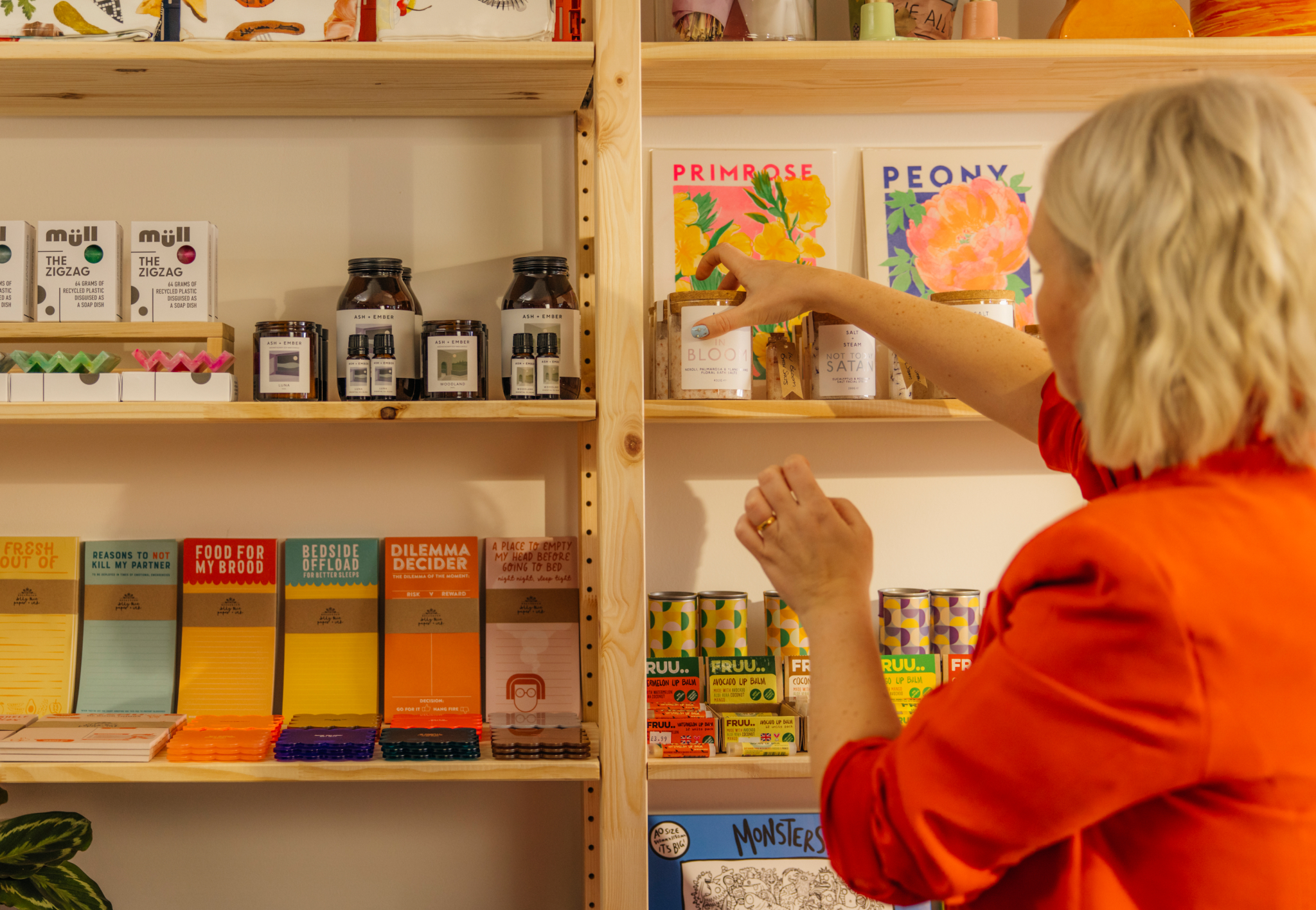

In today’s digital landscape, social media has become essential for retailers looking to connect with customers and grow their business. While regular posting is important, strategic campaigns can take your social presence to the next level, driving engagement, building brand awareness, and ultimately boosting sales.
What’s inside
To help you navigate this terrain, we spoke with Mavy Arias, the social media manager at Faire. With her deep understanding of retail audiences and platform dynamics, Mavy offers invaluable insights for independent retailers looking to elevate their social media presence.
“As someone who has led social media for a brand for the past six years, I know firsthand how impactful a well-planned organic social media campaign can be,” Mavy explains. “While I work on social strategy at a brand level, many of the same principles apply to retailers looking to increase visibility, drive engagement, and grow their customer base.”
Whether you have a plus-sized clothing store, a stationery store, or any retail business, well-executed campaigns can help you achieve specific goals and create meaningful connections with your audience. This guide will walk you through everything you need to know to create impactful social media campaigns for your retail business.
What’s a social media campaign?
According to Mavy, “A social media campaign is a focused effort to achieve a specific goal through social media over a set period. Unlike daily posts, a campaign is intentional, structured, and designed to drive measurable results.”
Think of it as the difference between casual conversations and a planned presentation—both have value, but campaigns allow you to deliver a cohesive message with purpose and direction.
What is the purpose of running a social media campaign?
Strategic social media campaigns give your retail business focused moments to shine, creating momentum and excitement around specific goals. Unlike everyday posts that maintain your presence, campaigns harness the power of concentrated effort and storytelling to move your audience to action.
Mavy’s advice is tangible and practical: “The key is to define a clear goal before launching your campaign,” she says. “This will guide your content and how you measure success.”
Some common goals for social media campaigns include:
-
Boosting brand awareness: Introducing your store to potential new customers who haven’t discovered you yet, expanding your visibility beyond your current followers.
-
Driving engagement: Building relationships through meaningful interactions with your audience, encouraging comments, shares, and conversations around your brand.
-
Increasing website traffic: Directing social followers to specific pages on your online store, turning social interest into browsing and shopping activity.
-
Growing your email or SMS list: Expanding your subscriber base for future marketing efforts, converting social followers into contacts you can reach directly.
-
Generating sales: Driving revenue through special offers or product launches, with clear calls to action that convert interest into purchases.
- Increasing foot traffic: Encouraging online followers to visit your store in person through special in-store events or offers.
Most effective campaigns focus primarily on one or two of these objectives, though you may see benefits across multiple areas.
Types of social media campaigns
Not sure where to start with your social media campaign? The right type of campaign can showcase your products, connect with your audience’s interests, and highlight what makes your retail business special. Here are some effective campaign formats that have proven successful for retailers across different industries. You can adapt these ideas to fit your specific products, target audience, and business goals.
Here are some effective campaign types that work particularly well for retailers:
-
Educational campaigns: Share your expertise and position your brand as an authority. A skincare boutique might run a “7 Days of Summer Skincare” series with daily tips that feature relevant products.
-
Seasonal collection launches: Build excitement around new merchandise with behind-the-scenes content, styling tips, and exclusive previews. A home decor store could showcase its new fall collection with daily features on different products and decor inspiration.
-
User-generated content challenges: Encourage customers to share photos with your products using a branded hashtag. A café might ask customers to share their favorite drink for a chance to be featured on the store’s profile.
-
Flash sales and exclusive promotions: Create urgency with limited-time offers available only to your social followers. A jewelry store could offer a 24-hour discount code exclusively shared through Instagram Stories.
- Customer appreciation campaigns: Highlight loyal customers by featuring their testimonials or photos on your feed. A bookstore might showcase “Reader of the Month” profiles to build community and show appreciation.

What social media channel should you use for which purposes?
Each social media platform has its own unique audience, content style, and features that make it better suited for certain types of campaigns. Understanding the strengths of each platform will help you make smarter decisions about where to invest your time and creativity.
If you are feeling overwhelmed, Mavy’s advice might bring some comfort. “Retailers should focus on one or two primary platforms where their audience is most active,” she says. “You don’t need to be everywhere. Focusing on the right platform will yield better results.”
-
Instagram and TikTok are ideal for visual storytelling, product showcases, and reaching younger demographics. These platforms work wonderfully for fashion, beauty, home decor, and lifestyle retailers who can create visually compelling content. A boutique clothing store might use Instagram to showcase styling options for a new collection through a series of Reels and carousel posts.
-
Facebook excels at community building, local store promotions, and event marketing. It’s particularly effective for retailers with a local focus who want to engage customers in their area. A neighborhood bookshop could use Facebook to promote an author-signing event and build excitement within their community.
-
Pinterest serves as a perfect platform for long-term discovery and inspiration, especially for home goods, fashion, DIY, and seasonal products. Content on Pinterest can drive traffic for months or even years. A craft supply store might create seasonal boards showcasing project ideas using their products.
-
LinkedIn works best for B2B retailers or high-end specialty stores targeting professionals. This platform suits luxury brands or retailers with business-focused offerings. An upscale office furniture showroom could highlight how their ergonomic designs improve workplace productivity.
- X (Twitter) proves useful for time-sensitive announcements, promotions, and quick customer interactions. Retailers can leverage this platform for immediate engagement and addressing customer service questions. A gourmet food shop might announce the arrival of a limited seasonal item that customers eagerly anticipate each year.
Retailers should focus on one or two primary platforms where their audience is most active.
The steps to a successful social media campaign
While spontaneity has its place in social media, the most successful retail campaigns follow a structured approach that maximizes results. Whether you’re planning your first campaign or looking to improve upon previous efforts, these key steps will help you develop a framework that turns good ideas into great outcomes. Think of this process as your road map to creating campaigns that not only catch attention but also drive meaningful business results.
Step 1: Develop a campaign idea
“A great campaign starts with a solid idea,” says Mavy. “Your campaign should align with your business goals while providing value to your audience.”
- Look for seasonal opportunities that relate to your products.
- Highlight your bestsellers in creative ways.
- Survey your customers to understand what they want to see.
- Research what’s working for similar retailers in your industry.
- Build campaigns around authentic customer stories.
Example: A sustainable clothing boutique might create a “30 Days of Sustainable Style” campaign showcasing how versatile eco-friendly pieces can be styled in multiple ways, reducing the need for fast-fashion purchases.
Step 2: Identify your target audience
Understanding exactly who you’re trying to reach will make your campaign more effective. Mavy says: “To make sure your campaign reaches the right people, define your ideal customer. Use social media insights (age, location, interests) to see who engages with your content.”
- Review your social media insights to see who currently engages with your content.
- Analyze your customer data to identify your most valuable customer segments.
- Check who follows and engages with similar brands.
- Consider creating different content for different audience segments.
The more specific you can be about who you’re targeting, the more tailored and effective your content will be.
Example: A children’s bookstore might discover that their most engaged audience isn’t just parents but specifically educators and grandparents who purchase gifts. This insight could lead them to create content that speaks directly to these groups during their back-to-school campaign.
Step 3: Define your goal and set KPIs
Your campaign should have one primary objective with clear metrics to track success:
- For brand awareness: Track reach, impressions, and follower growth.
- For engagement: Measure likes, comments, shares, and saves.
- For website traffic: Monitor click-through rates and time on site.
- For list growth: Count new email or SMS subscribers.
- For sales: Track conversion rates, discount code redemptions, and revenue.
Be specific with your goals—instead of “increase followers,” aim for “gain 500 new followers during our two-week campaign.”
Example: A confectionery planning a Valentine’s Day campaign might set a primary goal of increasing preorders by 25% compared with last year, with specific KPIs tracking social media click-throughs, conversion rate, and average order value.
Step 4: Create a content calendar
Planning your content in advance ensures consistency and reduces last-minute stress:
- Schedule posts two to four weeks ahead to allow time for content creation.
- Mix up content formats (Reels, Stories, carousels, static posts) for variety.
- Plan both promotional and value-driven content.
- Allow flexibility for real-time engagement opportunities.
Using a tool like Google Sheets, Notion, or a social media scheduling platform can help you stay organized and ensure nothing falls through the cracks.
Example: A handmade ceramics boutique launching a new collection might plan a four-week content calendar with different weekly themes: studio process videos, artist interviews, styling inspirations, and limited-time offers—scheduling specific dates for each post while allowing room for sharing customer reactions.
Step 5: Create and publish engaging content
Effective retail social content typically includes:
- High-quality visuals that showcase your products in their best light.
- Compelling captions with a strong hook and clear call to action.
- Consistent branding that reinforces your store’s unique identity.
- Strategic timing based on when your audience is most active.
Remember that great retail content focuses on the “why” behind the purchase: How will your products enhance your customers’ lives? For example, a kitchenware store shouldn’t just showcase a new pan—it should show the delicious meals that can be made with it and the joy of cooking for loved ones.
Example: A fair-trade coffee shop might create content for its farmer spotlight campaign that includes authentic videos from origin visits, comparison graphics showing its ethical pricing model, and carousel posts telling the stories of individual farmers with high-quality photography and warm, earth-toned branding throughout.
Step 6: Engage with your audience
“A campaign isn’t just about posting,” Mavy says. “It’s about creating conversations.”
A successful campaign will do the following:
- Respond promptly to all comments and messages.
- Use interactive features like polls and questions to encourage participation.
- Share user-generated content to showcase the community.
- Ask for feedback and incorporate it into future content.
This engagement not only builds relationships but also boosts your content in the algorithm, extending your reach.
Example: A plant shop running a summer care tips campaign might host weekly “Plant Doctor” Q&A sessions in Stories where followers submit photos of struggling plants for diagnosis, reshare customer success stories using its care tips, and have staff personally respond to detailed questions about difficult varieties.
Step 7: Analyze your campaign’s success
Once your campaign concludes, take time to review what worked and what didn’t:
- Compare your results against the KPIs you set initially.
- Identify your top-performing content and understand why it resonated.
- Note any unexpected outcomes or insights.
- Document learnings to apply to future campaigns.
Even if a campaign doesn’t hit all its targets, the insights gained are valuable for refining your approach next time.
Example: An activewear boutique might analyze its new collection campaign to discover that video content significantly outperformed static images, morning posts generated more engagement than evening content, and customer testimonials drove the highest website traffic—insights that would directly shape its content strategy for the next campaign.
Final thoughts
To create content that truly resonates, think beyond just promoting your products. Great social media content should:
- Educate – Teach your audience something useful.
- Entertain – Make them laugh, inspire them, or evoke emotion.
- Engage – Encourage conversation and interaction.
- Empower – Show how your product fits into their lifestyle.
The key is to show, not just sell. If your content provides value first, the sales will naturally follow.
We’ll give the last word to Mavy:
“Retailers don’t need massive budgets to run successful social media campaigns. Strategy, consistency, and engagement are the real game changers. By setting clear goals, understanding your audience, and consistently analyzing your results, you’ll create campaigns that truly connect with your customers and drive growth. If you’re new to running social media campaigns, start small, track your progress, and build from there.”



